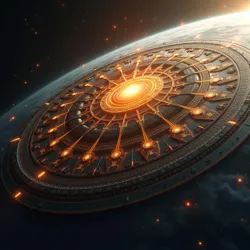Helios Concordat
The Helios Concordat stands as one of humanity's most influential interstellar religious organizations, combining traditional solar worship with advanced space-age theology. Established in 2387 following the Great Solar Revelation, the Concordat has evolved from a small group of devoted astronomers into a vast network of stellar temples, research facilities, and diplomatic missions that span multiple star systems.
 The Primary Orbital Sanctuary of the Helios Concordat, featuring its distinctive solar collection arrays arranged in sacred geometric patterns
The Primary Orbital Sanctuary of the Helios Concordat, featuring its distinctive solar collection arrays arranged in sacred geometric patternsOrigins and Foundation
The Helios Concordat emerged during humanity's early ventures into deep space, when a group of scientists stationed at the Solar Observatory Alpha reported experiencing simultaneous visions of ancient solar deities. These experiences, later documented in the Celestial Codex, led to the formation of a new religious movement that sought to understand the divine nature of stellar bodies through both scientific observation and spiritual contemplation.
Dr. Elena Solaris, the observatory's chief researcher, became the Concordat's first High Solar Archon after publishing her seminal work "Divinity Among the Stars," which laid the theoretical framework for combining empirical stellar research with religious devotion. Her approach attracted both scientists and spiritual seekers, establishing the foundation for the Concordat's unique dual nature.
Religious Philosophy
The Concordat's theology centers on the belief that stars are physical manifestations of the Astral Divinities, with our Sun representing the most direct connection to divine consciousness for humanity. Unlike traditional solar worship, the Concordat teaches that all stars possess varying degrees of divine awareness and influence, forming a vast network of celestial consciousness throughout the universe.
This belief system has been particularly influential in shaping human expansion into space, as Concordat teachings emphasize the importance of establishing Stellar Watchtowers near significant stellar bodies. These installations serve both as scientific observation posts and temples, allowing devotees to study and commune with different stellar entities.
Organizational Structure
The Helios Concordat operates through a complex hierarchy that mirrors their understanding of stellar evolution. At the top sits the Solar Conclave, led by the High Solar Archon and twelve Stellar Priests representing different aspects of stellar phenomena. Below them, various orders handle specific aspects of the Concordat's mission, from scientific research to diplomatic relations with other cosmic faiths.
The organization maintains close ties with the Path of Burning Light, despite their philosophical differences, as both groups share a commitment to understanding cosmic phenomena through careful observation. This relationship has proven particularly valuable during diplomatic missions aboard vessels like the Pilgrim's Bounty.
Scientific Contributions
While primarily a religious organization, the Concordat has made significant contributions to astronomical science through its network of observatories and research stations. Their most notable achievement has been the development of the Helios Array System, which combines traditional astronomical instruments with devices designed to measure what the Concordat terms "stellar consciousness emissions."
The organization's research division has worked closely with the Divine Realm Mapping Project, providing both technical expertise and theological insight into the nature of divine manifestations in space. Their data has proven particularly valuable in understanding the recently discovered Divine Convergence Zone.
Cultural Impact
The Helios Concordat's influence extends far beyond religious and scientific spheres, shaping human culture throughout explored space. Their architectural style, characterized by elaborate solar motifs and light-capturing structures, has influenced the design of numerous space stations and colonies. The annual Festival of Star Birth, introduced by the Concordat, has become a widely celebrated event even among non-believers.
Through their Solar Diplomacy Initiative, the Concordat has played a crucial role in mediating conflicts between various stellar nations and religious factions. Their emphasis on finding common ground between scientific understanding and spiritual belief has made them valuable intermediaries in disputes involving different approaches to cosmic phenomena.
Technological Developments
The Concordat's dedication to combining spiritual insight with scientific advancement has led to several breakthrough technologies. Their solar temples incorporate advanced energy collection systems that serve both practical and ceremonial purposes, while their stellar observation equipment includes unique instruments designed to detect subtle patterns in solar activity that traditional sensors might miss.
Their most significant technological achievement has been the development of the Divine Light Interface, a system that allows for direct observation of what the Concordat believes to be manifestations of stellar consciousness. While controversial among conventional scientists, this technology has gained acceptance among various religious orders and has been installed aboard several major research vessels.
Notable Members
Throughout its history, the Helios Concordat has attracted numerous influential figures who have shaped both the organization and humanity's understanding of the cosmos. Besides founder Dr. Elena Solaris, notable members have included Ambassador Kiran Solis, whose work with Navigator Esther Vale during the Divine Convergence crisis demonstrated the potential for cooperation between different spiritual traditions.
Current Activities
The Concordat currently focuses on expanding its network of Stellar Watchtowers while deepening its understanding of the Divine Convergence Zone. Their researchers work closely with various organizations, including the Bureau of Synthetic Divinity, to understand the implications of artificial intelligence systems exhibiting characteristics associated with stellar consciousness.
See Also
- Astral Divinities
- Stellar Consciousness Theory
- Solar Meditation Practices
References
- "Divinity Among the Stars" by Dr. Elena Solaris
- The Celestial Codex
- Archives of the Solar Conclave
- Proceedings of the Conclave of Digital Theologians
The Helios Concordat continues to evolve as humanity's understanding of the cosmos expands, maintaining its dedication to bridging the gap between scientific knowledge and spiritual wisdom while playing a crucial role in shaping the future of human space exploration and cosmic devotion.